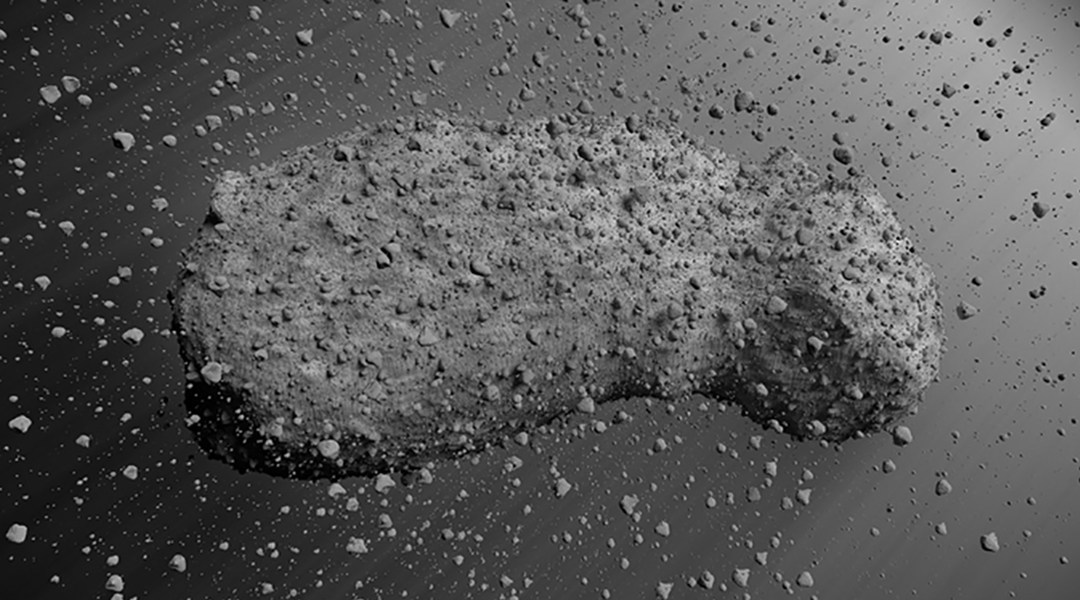If humanity needs to be reminded of the destructive power of an asteroid impact, all it needs to do is turn its attention to the Yucatán Peninsula in Mexico and the Chicxulub crater.
The over-six-mile-wide crater was carved into our planet when a massive space rock slammed into it over 65 million years ago, killing 75%of its species — including the dinosaurs.
Attempting to ensure humanity doesn’t meet this same fate, NASA recently slammed the DART spacecraft into a distant asteroid system to see how effectively an object on a collision course with Earth could be redirected. More than impressive displays of raw force alone, such asteroid diversion operations depend strongly on understanding the composition of asteroids and the material that comprises them.
Rubble pile asteroids
As part of an ongoing effort to do this, an international team of researchers have examined three tiny dust particles collected from the surface of the 500-meter-long asteroid, Itokawa, which is located around 1.2 million miles (2 million kilometers) from Earth.
Curtin University Professor Fred Jourdan led the research into the durability of Itokawa, an ancient asteroid made of rocky rubble and dust as old as the solar system itself. The aptly named study “Rubble Pile Asteroids are Forever” was published in the Proceedings of the National Academy of Sciences and revealed this rubble-pile asteroid is more durable than previously thought. This information could potentially contribute to saving Earth if such an asteroid was ever headed toward us.
“Asteroids are usually thought of as a big chunk of solid rock, but they are not all like that,” said lead author Jourdan. “Some are called rubble piles because they are rocks boulders and pebbles agglomerated together.”
Jourdan explained there are a lot of void spaces between the rocks of these rubble piles with Itokawa being half comprised of empty space. It is these extra void spaces that make rubble-pile asteroids highly shock-absorbent.
“Rubble pile asteroids, like Itokawa, are like giant space cushions. Cushions are so soft because there is a lot of air trapped in between the solid foam. So, it’s good to absorb shock,” he continued. “Same for rubble pile asteroids, they are just as good at absorbing shock. Shock absorbent bodies are generally harder to destroy.”
Jourdan, who is director of the Western Australian Argon Isotope Facility, part of the John de Laeter Centre and the School of Earth and Planetary Sciences at Curtin, pointed out that this means the results obtained by the team are important for planetary defence.
“The recent DART mission was a resounding success and showed us that we can push rubble pile asteroids by impacting spacecraft into them. The problem is that it requires us to detect these asteroids very early on since the push will be very small,” Jourdan said. “But what if we don’t have enough time? What if we suddenly discover that an asteroid will impact Earth within 3 months? What do we do?”
He suggests that given the nature of Itokawa, agencies like NASA should consider exploding a nuclear device very close to the asteroid, which would create a shock wave much more energetic than small kinetic impactors like DART. This would more strongly deviate the path of an incoming asteroid away from Earth.
“The fact that these asteroids are so resistant would play to our advantage, so the blast would not destroy it. Because exploding an asteroid is really not the way to go since all the debris would rain down and cause similar devastation,” Jourdan said.
A new theory for Itokawa’s age
The results also have other implications too, with the durability of Itokawa giving an indication of just how old it is. In the main asteroid belt between Mars and Jupiter, the survival time of solid monolithic asteroids the size of Itokawa is predicted to be much shorter than the 4.2-billion-year age of the solar system.
“Most models predicted that Itokawa should be only a few hundred of million years old,” Jourdan said. “But those models did not take into account the fact that the rubble pile structure which makes up asteroids of this type is much more resistant than previously thought and just good at absorbing shock when other smaller asteroids hit them.”
This new research points to the fact that the parent bodies of rubble pile asteroids can be obliterated early in the formation of the universe and then reform as rubble piles that can last in the asteroid belt for almost the entire duration of the solar system’s existence.
“What will surprise people about these results, is that Itokawa survived all this time in the asteroid belt, before being ejected and becoming an Earth-crossing asteroid in the last few million years or so,” Jourdan said.
The results were obtained by studying three grains from Itokawa which were brought back to Earth by the Hayabusa lander with two complementary techniques. Electron Backscattered Diffraction can measure if a space rock has been shocked by a meteor impact, while argon-argon dating can put a date on these impacts.
Jourdan said that the team has more grains from Itokawa that they are currently studying, and they are also aiming to extend their research to other asteroids. This will include working with samples returned from another rubble-pile asteroid, Bennu.
“Asteroids and meteorites in general can tell us how the solar system formed, how it evolved, how planets formed — pure blue-sky science if you want, and that is absolutely fascinating,” Jourdan concluded. “Frankly working on Earth and planets is what keeps me going back to work every day. This is so interesting!”
Reference: F. Jourdan. N. E. Timms., et al., Rubble pile asteroids are forever, Proceedings of the National Academy of Sciences, (2023). DOI: 10.1073/pnas.2214353120

















